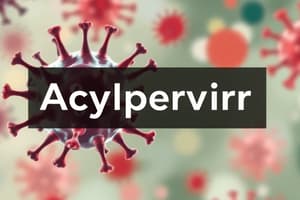Podcast
Questions and Answers
A patient with a herpes simplex virus (HSV) infection is being treated with acyclovir. What is the mechanism of action that allows acyclovir to be effective against HSV?
A patient with a herpes simplex virus (HSV) infection is being treated with acyclovir. What is the mechanism of action that allows acyclovir to be effective against HSV?
- Binding to the pyrophosphate-binding site of viral enzymes, preventing kinase activation.
- Directly inhibiting the viral thymidine kinase, preventing the initial phosphorylation of the drug.
- Inhibition of viral DNA polymerase, which subsequently inhibits the replication of viral DNA. (correct)
- Causing direct incorporation into the viral DNA, leading to chain termination without prior activation.
Why is foscarnet reserved as a last-line treatment option for viral infections?
Why is foscarnet reserved as a last-line treatment option for viral infections?
- It requires multiple kinase activation steps, which often leads to drug resistance.
- It has severe toxicities, including extreme nephrotoxicity and significant electrolyte disturbances. (correct)
- It primarily targets RNA polymerase, which is not effective against DNA viruses.
- It has a narrow spectrum of activity, limited only to acyclovir-sensitive strains of HSV.
A patient with a history of renal impairment is prescribed acyclovir for a herpes zoster infection. Which precaution should be implemented to minimize the risk of adverse effects?
A patient with a history of renal impairment is prescribed acyclovir for a herpes zoster infection. Which precaution should be implemented to minimize the risk of adverse effects?
- Prescribe a concurrent loop diuretic to enhance renal clearance of the drug.
- Ensure the patient maintains adequate hydration and infuse the drug slowly. (correct)
- Administer the drug via rapid bolus injection to ensure rapid therapeutic levels.
- Monitor liver function tests weekly to detect early signs of hepatic toxicity.
How does cidofovir's mechanism of action differ from that of acyclovir in treating cytomegalovirus (CMV) infections?
How does cidofovir's mechanism of action differ from that of acyclovir in treating cytomegalovirus (CMV) infections?
A patient taking ganciclovir for CMV retinitis develops neutropenia. Which concurrent medication would most likely exacerbate this side effect?
A patient taking ganciclovir for CMV retinitis develops neutropenia. Which concurrent medication would most likely exacerbate this side effect?
Which antiviral agent is most appropriate for oral administration in patients requiring long-term treatment for cytomegalovirus (CMV), and why?
Which antiviral agent is most appropriate for oral administration in patients requiring long-term treatment for cytomegalovirus (CMV), and why?
A patient is diagnosed with acyclovir-resistant herpes simplex virus (HSV). Which antiviral agent would be most effective in treating this patient's infection?
A patient is diagnosed with acyclovir-resistant herpes simplex virus (HSV). Which antiviral agent would be most effective in treating this patient's infection?
A patient receiving foscarnet for a resistant herpes simplex virus (HSV) infection develops severe hypocalcemia. What is the most appropriate immediate intervention?
A patient receiving foscarnet for a resistant herpes simplex virus (HSV) infection develops severe hypocalcemia. What is the most appropriate immediate intervention?
A patient develops nephrotoxicity while on cidofovir treatment. Which combination of drugs must be avoided to prevent possible drug interactions that can worsen nephrotoxicity?
A patient develops nephrotoxicity while on cidofovir treatment. Which combination of drugs must be avoided to prevent possible drug interactions that can worsen nephrotoxicity?
Which of the following is a critical monitoring parameter for patients receiving cidofovir to prevent severe adverse effects?
Which of the following is a critical monitoring parameter for patients receiving cidofovir to prevent severe adverse effects?
Flashcards
Acyclovir & Valacyclovir
Acyclovir & Valacyclovir
Inhibit viral DNA polymerase, stopping viral DNA replication. Effective against HSV-1, HSV-2, and varicella-zoster virus.
Foscarnet
Foscarnet
Extreme nephrotoxicity and electrolyte disturbances. Reserved for resistant cases due to severe side effects. Doesn't require kinase activation.
Cidofovir
Cidofovir
Inhibits viral DNA replication without needing activation by viral thymidine kinase. Effective against CMV and acyclovir-resistant HSV.
Valganciclovir
Valganciclovir
Signup and view all the flashcards
Ganciclovir
Ganciclovir
Signup and view all the flashcards
Acyclovir Activation
Acyclovir Activation
Signup and view all the flashcards
Foscarnet Side Effects
Foscarnet Side Effects
Signup and view all the flashcards
Cidofovir Side Effects
Cidofovir Side Effects
Signup and view all the flashcards
Acyclovir/Valacyclovir Side Effects
Acyclovir/Valacyclovir Side Effects
Signup and view all the flashcards
Study Notes
- There is no vaccine available for herpes infection.
- Pharmacological management involves treating the underlying condition.
Anti-Herpes Agents
- Require three phosphorylation steps for activation.
- First converted to the monophosphate derivative by the virus-specified thymidine kinase, then di-, then tri-.
- Activity against herpesviruses directly correlates with the virus's capacity to induce thymidine kinase.
- Nucleoside to monophosphate conversion, or monophosphate to diphosphate conversion is blocked by anti-herpes antivirals.
- Inhibit viral DNA polymerase in order to inhibit replication of viral DNA.
- Used for treatment of herpes simplex and varicella-zoster virus.
- Acyclovir, valacyclovir (prodrug of acyclovir) and famciclovir (also a prodrug of Acyclovir) and penciclovir (topical only for cold sores).
- Effective against HSV-1, HSV-2, and varicella zoster virus.
- Contraindicated in individuals with renal failure due to the risk of seizures.
- Side effects of acyclovir and valacyclovir include seizures (especially with renal impairment) and obstructive crystalline nephropathy.
Preventing Crystalline Nephropathy
- Infuse slowly.
- Maintain adequate hydration.
- Cytomegalovirus antivirals inhibit viral DNA/RNA polymerase and HIV reverse transcriptase.
- Cytomegalovirus drugs bind to the pyrophosphate-binding site of enzyme and do not require kinase activation.
Foscarnet
- Used for resistant cases of herpes.
- Does not require kinase activation, so resistance is rare.
- Has severe toxicity, specifically extreme nephrotoxicity and electrolyte disturbances.
- Reserved for last-line treatment.
- Effective against CMV and resistant HSV.
- Side effects include nephrotoxicity and electrolyte disturbances (hypo- or hypercalcemia, hypo- or hyperphosphatemia, hypokalemia, hypomagnesemia), all causing seizures.
- Concurrent use with amphotericin B, aminoglycosides, loop diuretics, tacrolimus, cyclosporine, or cisplatin increases the risk of nephrotoxicity
- Used for CMV retinitis in patients who fail ganciclovir and acyclovir-resistant HSV.
Cidofovir
- Used in the treatment of cytomegalovirus.
- Inhibits replication of viral DNA- nucleotide analogue that does not need to be activated by thymidine kinase.
- Effective against CMV and resistant HSV.
- Side effects include nephrotoxicity, neutropenia, and metabolic acidosis.
- Monitor blood markers of blood urea nitrogen (BUN) and serum creatinine (SCr).
Ganciclovir and Valganciclovir
- Ganciclovir (HD) is the first-line drug used.
- Valganciclovir is the prodrug of Ganciclovir.
- Valganciclovir can be administered orally.
Resistant Cases
- Treated with Foscarnet and Cidofovir.
- Significant side effects.
- Effective against CMV and resistant HSV.
- Side effects include myelosuppression, nephrotoxicity, and seizures.
- Concurrent use of immunosuppressive drugs increases the risk of myelosuppression.
- Concurrent use of amphotericin B, aminoglycosides, loop diuretics, tacrolimus, cyclosporine, or cisplatin increases the risk of nephrotoxicity.
Studying That Suits You
Use AI to generate personalized quizzes and flashcards to suit your learning preferences.




